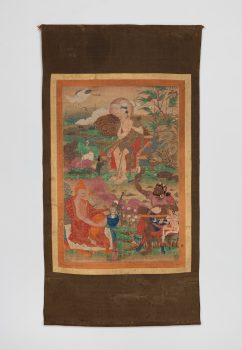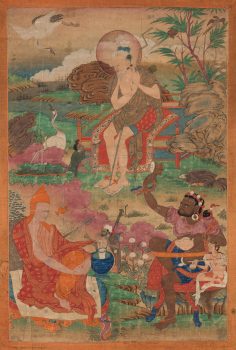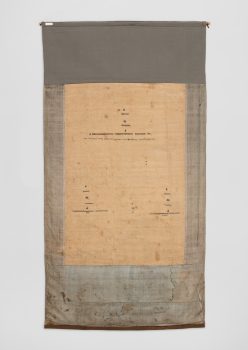Tibet
ca. 17th century



Tibet
ca. 17th century



This painting is from a large set depicting the eighty-four great Tantric adepts (mahasiddha) and portrays three of them, including both monastic and lay yogis. The top figure in the work is Kamala, who was a lay scholar, grammarian, and logician. He is shown as an old man with a tiny rolled-up text in his earlobe. At the bottom left is the monastic Suvarnadvipa, a scholar of great learning revealed by his pandita hat, an accessory reserved for highly educated scholastics. At the lower right is Viraya, the cooking oil seller and yogi, playing a hand drum. His right leg is held in place by a meditation strap, and he is accompanied at his side by his consort holding a sitar.Although required to follow a strict set of rules regarding iconography, the painter has infused each of the adepts in this work with his own personality. This finely crafted painting is a delicate balance of colors. It abounds with details to draw the eye, from the subtle gold accents and wide variety of intricate textile patterns to the turtle being offered to Kamala at top and the colorful parrot sitting in the crook of a staff below.
A religious movement that originated in India around the fifth to seventh century with sacred writings and esoteric teachings and practices transmitted from teacher to student through initiation. These remain an important part of Hinduism and Buddhism today.
The passing down of authentic Buddhist teachings from a teacher to a disciple or student, often in the form of a text in a ritualistic context.
The transmission of teachings from one generation to the next, from teacher to student, traced all the way back to the Buddha without interruption. A complete lineage is essential in Tantric Buddhist practices as it makes the blessings of the teaching more powerful.
Himalayan art includes portraits of legendary and historical humans, including accomplished religious teachers (lamas), the Buddha’s original disciples (arhats), and spiritually accomplished tantric masters (mahasiddhas).
Today, Tibetans primarily inhabit the Tibetan Plateau, situated between the Himalayan mountain range and the Indian subcontinent to the west, Chinese cultural regions to the east, and Mongolian cultural regions to the northeast. During the 7th to 9th century, Tibetan rulers expanded their empire across Central Asia, and established Buddhism as the state religion.
Get the latest news and stories from the Rubin, plus occasional information on how to support our work.